22 May Kurt Vonnegut Jr. as Visual Artist – An Interview with Heather Rose
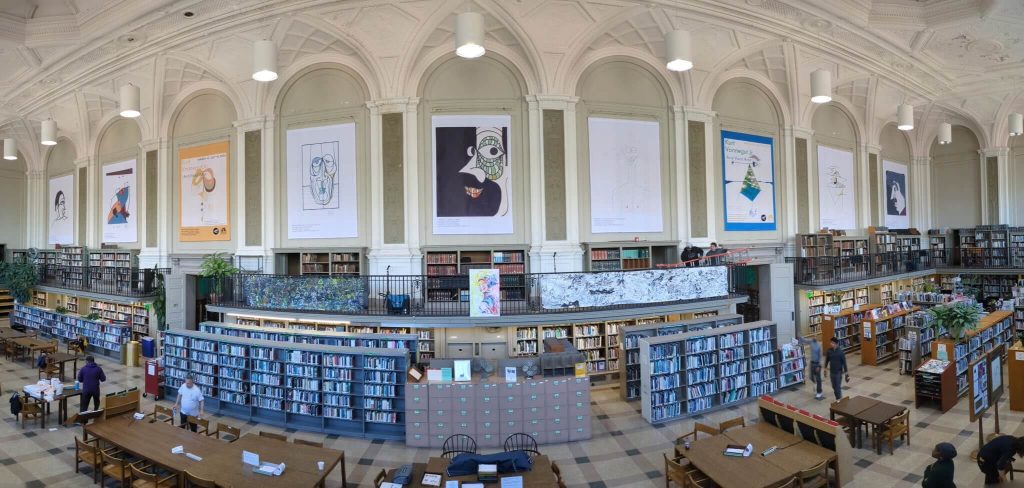
Kurt Vonnegut Jr. As a Visual Artist installation. 14 Mar.-19 Jul, Free Library of Philadelphia Parkway Central Library Art & Literature Department, Philadelphia.
Readers of Kurt Vonnegut’s classic 1973 novel Breakfast of Champions know that Vonnegut liked to draw. Vonnegut’s illustrations included the American flag, female underpants, a dinosaur, and the asterisk-like depiction of a sphincter that became a familiar symbol for the remainder of his career. Hardcore fans may also have read 2014’s Drawings, which features “My Father, The Doodler” by Nanette Vonnegut and an extended essay by Vonnegut scholar Peter Reed, along with nearly 150 pages of Vonnegut’s art.
What’s been rare, until now, is the opportunity to view Vonnegut’s original art in a gallery setting. Fortunately, a new exhibit, Kurt Vonnegut Jr. as a Visual Artist, at the Paul Peck Alumni Gallery on the campus of Drexel University in Philadelphia offers visitors the chance to explore over 25 of Vonnegut’s drawings.
Vonnegut often wrote of “secular saints,” people who behave decently in an often-indecent world. The secular saint behind the new exhibit is Heather Rose, a Drexel graduate, owner of the collection, and a passionate advocate for Vonnegut’s visual art. At the opening night panel Rose described Vonnegut’s art as “suggestive, playful, and open to interpretation.”
During a tour of the gallery, I spoke with Rose about the exhibit.
Q: How did you first get interested in Vonnegut’s art?
Heather Rose: Obviously I’m a huge fan, and things started for me when I was watching a documentary (Unstuck in Time) about Vonnegut and some of the filler in it were images of his drawings. I thought, “Gosh, darn it, is there anything he’s not good at? I love him as a visual artist now, too.”
I wasn’t super familiar with him as a visual artist, of course, other than stuff he had drawn in his books. Possibly I had known about a bit of stuff outside of his books, things that had percolated up as individual pieces of his silhouette style signature, but nothing standalone. I started doing a bit of research and fell across Joe Petro’s collaborative work with him, purchased Identical Twin, and reached out to Joe.
I figured I was throwing away an email, thinking, “”Whatever, there’s no chance I’ll hear for this guy.” But he called me. He’s from Kentucky, and I had lived in Kentucky, which is a point of connection. I actually also grew up in Indiana, which is also a point of my intersectional connection with Vonnegut and Indianapolis. That was our jumping off place. Joe and I started talking about his pieces on the odd chance I could acquire something. I really did want an original; just the thought of having something that Vonnegut had himself actually touched was meaningful to me.
Ultimately Joe decided he wasn’t comfortable with it, but he was very gracious and helpful to me and I adore his prints. He helped me along the way in finding connections and making sure the work was actually Vonnegut’s.
Q: Nanette Vonnegut appeared at the opening of the exhibit. Do you have a relationship with the Vonnegut family?
Heather Rose:I have only met Nanette and she is lovely, and clearly very intelligent. From what I can tell of them, the whole family is so smart, and private. While I own the original works in the collection, I still felt it was important to reach out to the family and to the Wylie Agency, which represents Kurt Vonnegut’s literary estate. I didn’t want to surprise anyone with the fact that I owned this art. It felt incredibly intimate to hold and share Kurt’s drawings, and I wanted to be in conversation with the family from the beginning, not just to honor their wishes, but because I believe this work deserves to be handled with care and collaboration. I’m so glad I took that approach. The family has been incredibly supportive, and getting to know Nanette has been a real gift.
Q: Some of the pieces appear to be marker on a sketch pad.
Heather Rose: Yes, it’s marker from the early Eighties on a sketch pad. Luckily it sat in a basement because these are all fugitive ink, meaning that light will break them down. I’ve had them all deacidified as a measure to protect them, and then I’ve had them all matted on Library of Congress acid-free mat put into anti-reflective, UV protective acrylic. It was quite an expensive outlay, but to me it was really important that I slowed down time as much as possible and made them available to the public.
Those were two very important things, because I feel like it’s crazy that he is such a good visual artist and so few people know it. It was a really strong drive in me to make these available to the public and make sure people got to know him as a visual artist. I think he’s fantastic.
Q: Is there a particular piece that most people claim as their favorite?
Heather Rose: At this point, I’ve had probably over 50 people tell me their favorite and there’s almost no continuity, which is to me a testament to how diverse I think the audience is for his art style. His art is very much like his writing in that it is very collaborative. I think you have to participate in it, you have to look at it and draw a conclusion from it, and it’s your own conclusion. Different people can arrive at different conclusions about its meaning. I liken that to “so it goes”. What is the meaning of “so it goes?” People infuse a lot of their own meaning, but it is very much Vonnegutian in that way.
As Rose and I toured the exhibit, she offered her perspective on the different pieces, providing insightful commentary that helped me see aspects I initially missed.
Rose identified one work as possibly a drawing of Mona Aamons Monzano, the beautiful adopted daughter of “Papa” Monzano in Cat’s Cradle. In Vonnegut’s art, images recur the way characters often recurred in his fiction. Another drawing appeared to be Salo, the mechanical messenger from Tralfamadore from The Sirens of Titan.
Heather Rose: I asked Nanette. I said, “To me, this one harkens to Salo, and she said, “He would probably agree with you.” And I was like, “I’ll take that!” Obviously, there’s certain aspects that are off like the number of eyes, but he had a rotating head. It’s arguable if it’s even a head. But this one’s playful and I just really enjoy it.
Another drawing echoed the familiar “self-portrait” Vonnegut often drew.
Heather Rose: It does have that spiral and the curly locks, and it does have a curly brown mustache. I see a lot of similarities. It’s almost like a younger version, a less pointy nose, and he’s not smoking, which was obviously quite a hallmark.
A personal favorite of mine feature three crucifixes on a hill, each forming a bold “T” and the repeated word “Thirst,” spelled out three times.
Heather Rose: Someone thought they were power lines. I think it represents Jesus being thirsty on the cross. There’s a famous hill, I believe, with the image of the three crosses. Vonnegut’s relationship with religion was that he was a pretty outspoken atheist. For him, Jesus was a person.
Much like Vonnegut’s fiction, many of the works include elements of science fiction.
Heather Rose: This one feels like it is about dimensionality. I feel like the stairs are taking you somewhere and you can re-emerge through the rug. This one…it’s about time and travel. Obviously I’m infusing a tremendous amount of my own perception here. I love how he’s bisected the painting with color. It’s incredibly well done.
While we can’t reproduce the art along with the interview, I was given some images to share, and for readers anywhere near Philadelphia, it’s worth the trip. The exhibit is scheduled to run through July 19.
Q: In the foyer, as one enters the gallery, there’s a section of the wall filled with sticky notes. Are they part of the exhibit?
Heather Rose: We had a terrific opening night. Over 120 people came. The theme of the evening was infrastructures of support in society, which I think is something Kurt Vonnegut really cared about. Nanette Vonnegut was part of the opening night panel and spoke beautifully about her father’s approach to visual art. The Free Library of Philadelphia was a great partner, and Jane Golden, the CEO of Mural Arts Philadelphia, gave our keynote. She’s such an inspiring advocate for bringing people together and strengthening neighborhoods through art. Mural Arts also brought in the artist David Coleman, who led a collaborative piece where people wrote responses to the prompt “what is your thing?” on sticky notes, and he turned them into a mural based on what the community shared. Reverend Barry Lynn, former counsel for the ACLU, founder of Americans United for Separation of Church and State, as well as a big Vonnegut fan, moderated the panel. As a longtime advocate for fairness and free expression, he guided this great conversation about how libraries, community centers, and public art can serve as critical infrastructures for resilience and equality, which ties right into Vonnegut’s work. We also had Lucas Zullo from Jefferson Health’s David Farber ASPIRE Center, which focuses on suicide prevention, talk about mental health and how community support plays a role. Andrew Zitcer, a professor and urban strategist from Drexel, spoke about how public space and cooperation can strengthen democracy. And Lynne Tropea Haase from the Free Library’s Central Children’s Department talked about how libraries provide access, refuge, and creative inspiration. Nanette also spoke powerfully about infrastructures of support and how making art impacted her father. It was really just a fantastic night.
Q: How did you become such a Vonnegut fan? Was there a certain book you read or a moment when suddenly something clicked?
Heather Rose: Yeah, it started with a book, with Breakfast of Champions. When I read it, I was like “Oh my God, somebody’s actually saying it like it is.” In the beginning, when he is talking about how people treated Native Americans and about colonialism and about race, the stratification of different races and economic stratification, I thought, “This person’s writing this in a very accessible way for somebody my age.” I don’t remember how old I was, but I knew it was really, really good writing. And then there’s humor, so much humor, and at the end, when he (Vonnegut) visits the protagonists and enters the story, I thought, “This is fucking great.”
And then I read Slaughterhouse-Five, I believe, and I was just like, “Damn.” The whole foreword about how it was really kids going to war, it’s not adults. I realized what he had been through as a human and how mission-driven he was to try to iron out stuff through his writing, how much he was processing stuff. I just genuinely thought he was far into the talent spectrum as an author.
As we finished touring the exhibit, Rose again stressed her admiration.
Heather Rose: The fact that these are doodles to him is very humorous, I think, because they’re so good. They’re just so good. I never got a chance to meet him. There was a certain point where I had (the artwork) briefly in my home and I thought, “I cannot believe I have all this stuff created by Kurt Vonnegut in my house.” It really blew my mind. I wish I had had a chance to meet him. I probably would’ve been a stammering idiot, but I would have loved to meet him.
At the opening night panel, artist and emcee Ajene Livingstone called the Vonnegut exhibit “a timely reflection on the power of artistic expression in uncertain times.” Vonnegut, who encouraged people to practice the arts as a way to make their souls grow, achieved fame as a writer, but as writing occupied less of his energy, later in life, he still practiced the arts, enjoying collaborations in music with Richard Alden Clark and with Kentucky artist Joe Petro with visual arts. Vonnegut’s daughter Nanette, commented on opening night, that the “drawings were a form of saving his life, later in life.”
Heather Rose, a caring steward of Vonnegut’s drawings, deserves kudos for sharing her collection and helping foster Vonnegut’s legacy as a visual artist. To paraphrase Kurt, “If that isn’t nice, what is?”
The exhibit, Kurt Vonnegut Jr. as a Visual Artist, runs through July 19 at the Peck Center Gallery at 3142 Market Street, Philadelphia. For more, visit here.


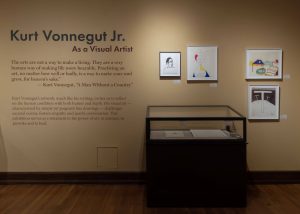
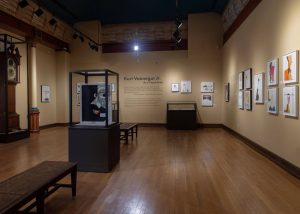
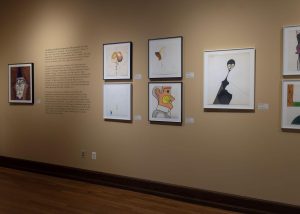
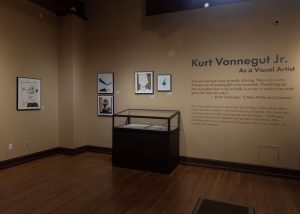
Ellen Cobb Church
Posted at 19:07h, 31 MayChuck, This is beautifully written and perfectly captures the essence of the exhibition! Thank you so much for sharing the exhibition and Heather’s enthusiasm for Kurt’s art and her delight in sharing it with others here where Vonnegut fans gather. . I am grateful that we connected and that you experienced this wonderful exhibition. Warmest regards, Ellen
Heather Rose
Posted at 13:30h, 07 JuneThank you for the thoughtful and generous coverage of the exhibition, Chuck. It was such a pleasure to meet you and share the collection — I’m grateful for the care you took in capturing the spirit of the show and Vonnegut’s visual work. We’ve had over 900 visitors so far, and the response has been incredibly moving. For anyone interested, the exhibit is on view at Drexel University through July 19 — I hope you’ll stop by if you’re in Philadelphia!